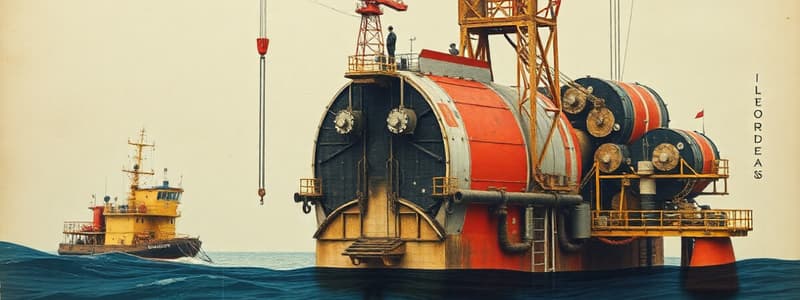Podcast
Questions and Answers
What primary factor contributed to the crane hook striking the diver's helmet during the subsea spool tie-in operations?
What primary factor contributed to the crane hook striking the diver's helmet during the subsea spool tie-in operations?
- The diver's failure to maintain a safe distance from the pipe handling frame (PHF).
- Insufficient length of the crane pennant/stinger, reducing the distance between the divers and the crane hook. (correct)
- Inadequate lighting conditions on the seabed, impairing visibility for the diver.
- The crane operator's lack of experience in subsea lifting operations.
Why did the crane operator mistakenly believe the crane hook had reached the seabed?
Why did the crane operator mistakenly believe the crane hook had reached the seabed?
- The crane hook came to rest on the top beam of the PHF, resulting in a 'no weight' reading. (correct)
- Strong underwater currents pushed the crane hook away from the intended target area.
- The crane's depth monitoring system malfunctioned during the operation.
- The diving supervisor provided incorrect depth information to the crane operator.
Besides an adequate crane pennant and stinger, what other actions could be taken to enhance safety and prevent similar incidents?
Besides an adequate crane pennant and stinger, what other actions could be taken to enhance safety and prevent similar incidents?
- Increase the number of divers involved in the operation to improve overall awareness.
- Rely solely on the diving supervisor's judgment to determine the equipment's location.
- Reduce the pre-operation briefing time to minimise fatigue among the diving team.
- Use alternative methods such as underwater cameras or sonar to track equipment position in poor visibility. (correct)
How did the diver avoid injury when the crane hook struck their helmet?
How did the diver avoid injury when the crane hook struck their helmet?
What specific communication practice should be reinforced to prevent similar incidents in the future?
What specific communication practice should be reinforced to prevent similar incidents in the future?
Flashcards
Crane Hook Incident Cause
Crane Hook Incident Cause
In subsea operations, a crane hook unexpectedly struck a diver's helmet during spool tie-in due to assumptions and poor visibility.
Factors causing crane hook incident
Factors causing crane hook incident
Inadequate length of crane pennant/stinger. Poor Visibility.
Preventative safety measures
Preventative safety measures
Maintain adequate distance between divers and crane hook using sufficient pennant/stinger length. Use visibility aids like cameras, sonar, or beacons.
Communication Improvement
Communication Improvement
Signup and view all the flashcards
Positive Actions Taken
Positive Actions Taken
Signup and view all the flashcards
Study Notes
- During subsea spool tie-in operations a crane hook unexpectedly struck a diver's helmet
What Happened
- Divers working on the seabed in poor visibility during subsea spool tie-in operations.
- After landing the pipe handling frame (PHF), the Diving Supervisor told the crane operator to lower the crane hook to disconnect rigging.
- The crane operator said that there was 'no weight' on the crane wire.
- The Diving Supervisor assumed the hook touched the seabed and told the diver to disconnect the PHF from the crane.
- While a diver was under the PHF disconnecting rigging, the crane hook struck the diver's helmet.
- The diver was unharmed and returned to the dive bell, after which the dive was aborted.
- Inspection found the diver's reclaim helmet to be damaged beyond repair, including the side block.
- The helmet's integrity remained intact despite the impact, demonstrating durability
What Went Right
- Diver 2 promptly assisted Diver 1, ensuring no injuries were sustained.
- Both divers returned to bell safely.
- Divers and the crane block had locating beacons fixed to them enabling accurate tracking.
- All procedures, lifting plans, and Job Hazard Analysis (JHA's) were followed.
- Protective equipment absorbed the impact, preventing diver injury
What Went Wrong
- The crane hook rested on the PHF's top beam during lowering for rigging disconnection.
- The crane operator assumed the hook reached the seabed due to a 'no weight' reading.
- As the diver approached the disconnection point, the hook slipped off the beam and struck the side of the helmet
Cause
- Inadequate length of crane pennant/stinger did not provide a wide enough gap between divers and the crane hook
- Poor visibility hindered the ability to accurately assess crane hook position
Lessons and Actions
- Ensure adequate distance between divers and crane hook.
- Crane pennant/stinger length should maintain a safe gap between divers and the crane hook during subsea operations to reduce inadvertent contact in conditions of limited visibility
- Use Enhanced visibility aids and monitoring.
- Use alternate solutions in low visibility, such as additional locating beacons, underwater cameras, or sonar to better identify the location of critical equipment like the crane hook.
- Better monitoring procedures can help prevent location miscalculations for the crane hook
- Reinforce communications and challenge assumptions.
- Reduce assumptions concerning equipment position.
- Ensure clear communication and confirmation procedures between the dive supervisor, crane operator, and divers to better understand equipment location.
Additional Member Actions
- Updated project procedures to specify minimum pennant lengths for different operations.
- Conducted pre-operation inspections of all rigging and lifting equipment, including crane hooks and pennants, to ensure they meet safety standards and are appropriate for the operation.
- Updated the Job Hazard Analysis (JHA) to incorporate lessons learned from this incident, particularly regarding safe distances, visibility, and communication requirements for subsea lifting operations.
Studying That Suits You
Use AI to generate personalized quizzes and flashcards to suit your learning preferences.




